亚文化与消费者心理
- 格式:ppt
- 大小:197.50 KB
- 文档页数:16
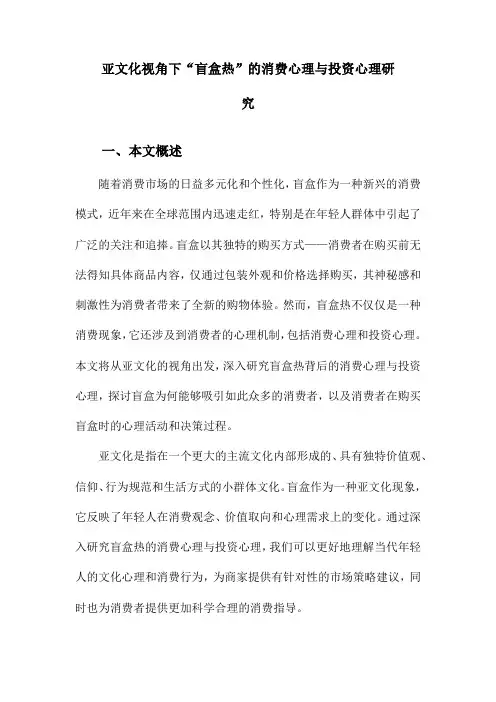
亚文化视角下“盲盒热”的消费心理与投资心理研究一、本文概述随着消费市场的日益多元化和个性化,盲盒作为一种新兴的消费模式,近年来在全球范围内迅速走红,特别是在年轻人群体中引起了广泛的关注和追捧。
盲盒以其独特的购买方式——消费者在购买前无法得知具体商品内容,仅通过包装外观和价格选择购买,其神秘感和刺激性为消费者带来了全新的购物体验。
然而,盲盒热不仅仅是一种消费现象,它还涉及到消费者的心理机制,包括消费心理和投资心理。
本文将从亚文化的视角出发,深入研究盲盒热背后的消费心理与投资心理,探讨盲盒为何能够吸引如此众多的消费者,以及消费者在购买盲盒时的心理活动和决策过程。
亚文化是指在一个更大的主流文化内部形成的、具有独特价值观、信仰、行为规范和生活方式的小群体文化。
盲盒作为一种亚文化现象,它反映了年轻人在消费观念、价值取向和心理需求上的变化。
通过深入研究盲盒热的消费心理与投资心理,我们可以更好地理解当代年轻人的文化心理和消费行为,为商家提供有针对性的市场策略建议,同时也为消费者提供更加科学合理的消费指导。
本文的研究内容主要包括以下几个方面:分析盲盒热的产生背景和发展现状,明确研究问题和研究意义;从消费心理和投资心理两个层面,深入探讨盲盒热背后的心理机制;接着,通过实证研究方法,收集和分析消费者在购买盲盒时的心理数据和行为数据,验证理论假设;根据研究结果,提出针对性的建议和对策,以促进盲盒市场的健康发展。
本文的研究不仅有助于深化对盲盒热现象的理解,也为相关领域的研究提供了有益的参考和借鉴。
本文的研究结果对于商家和消费者都具有重要的实践指导意义,有助于推动盲盒市场的可持续发展。
二、亚文化视角下的盲盒热盲盒热,作为近年来在中国乃至全球范围内兴起的消费现象,不仅反映了当代年轻人的消费习惯,更在某种程度上体现了亚文化的影响力。
亚文化,作为一种边缘性、抵抗性的文化形态,往往通过特定的符号、行为和价值观,表达着特定群体的独特身份和认同感。

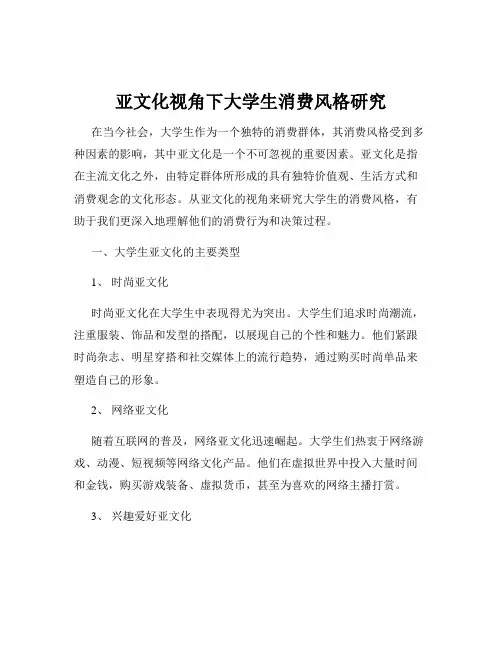
亚文化视角下大学生消费风格研究在当今社会,大学生作为一个独特的消费群体,其消费风格受到多种因素的影响,其中亚文化是一个不可忽视的重要因素。
亚文化是指在主流文化之外,由特定群体所形成的具有独特价值观、生活方式和消费观念的文化形态。
从亚文化的视角来研究大学生的消费风格,有助于我们更深入地理解他们的消费行为和决策过程。
一、大学生亚文化的主要类型1、时尚亚文化时尚亚文化在大学生中表现得尤为突出。
大学生们追求时尚潮流,注重服装、饰品和发型的搭配,以展现自己的个性和魅力。
他们紧跟时尚杂志、明星穿搭和社交媒体上的流行趋势,通过购买时尚单品来塑造自己的形象。
2、网络亚文化随着互联网的普及,网络亚文化迅速崛起。
大学生们热衷于网络游戏、动漫、短视频等网络文化产品。
他们在虚拟世界中投入大量时间和金钱,购买游戏装备、虚拟货币,甚至为喜欢的网络主播打赏。
3、兴趣爱好亚文化基于不同的兴趣爱好,大学生们形成了各种亚文化群体,如音乐爱好者、运动爱好者、摄影爱好者等。
他们会为了追求自己的兴趣爱好,购买相关的器材、设备和周边产品。
4、社交亚文化社交亚文化在大学生中也占据重要地位。
他们通过参加社团活动、聚会等社交场合,建立自己的社交圈子。
在这个过程中,消费行为往往成为融入群体和展示身份的方式,比如共同消费某种品牌的饮品或参加特定的娱乐活动。
二、亚文化对大学生消费风格的影响1、追求个性化亚文化强调个体的独特性和与众不同,这使得大学生在消费时更倾向于选择能够彰显个性的产品和服务。
他们不再满足于大众化的商品,而是追求具有独特设计、限量版或定制化的物品,以突出自己在群体中的独特地位。
2、注重情感体验大学生在亚文化的影响下,消费不仅仅是为了满足物质需求,更注重情感上的体验。
例如,参加一场音乐节、观看一场偶像的演唱会,或者购买一件与自己喜欢的动漫角色相关的周边产品,这些消费行为能够给他们带来愉悦、兴奋和满足感。
3、受社交圈子影响大在亚文化群体中,社交互动频繁,消费行为往往具有一定的传染性。
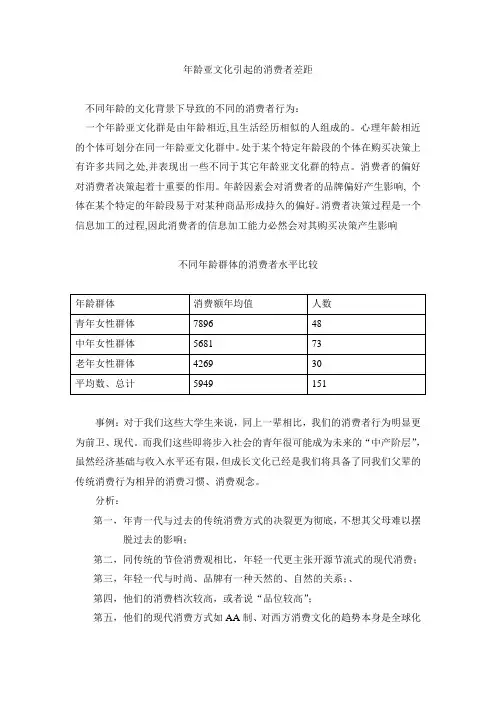
年龄亚文化引起的消费者差距
不同年龄的文化背景下导致的不同的消费者行为:
一个年龄亚文化群是由年龄相近,且生活经历相似的人组成的。
心理年龄相近的个体可划分在同一年龄亚文化群中。
处于某个特定年龄段的个体在购买决策上有许多共同之处,并表现出一些不同于其它年龄亚文化群的特点。
消费者的偏好对消费者决策起着十重要的作用。
年龄因素会对消费者的品牌偏好产生影响, 个体在某个特定的年龄段易于对某种商品形成持久的偏好。
消费者决策过程是一个信息加工的过程,因此消费者的信息加工能力必然会对其购买决策产生影响
不同年龄群体的消费者水平比较
事例:对于我们这些大学生来说,同上一辈相比,我们的消费者行为明显更为前卫、现代。
而我们这些即将步入社会的青年很可能成为未来的“中产阶层”,虽然经济基础与收入水平还有限,但成长文化已经是我们将具备了同我们父辈的传统消费行为相异的消费习惯、消费观念。
分析:
第一,年青一代与过去的传统消费方式的决裂更为彻底,不想其父母难以摆脱过去的影响;
第二,同传统的节俭消费观相比,年轻一代更主张开源节流式的现代消费;
第三,年轻一代与时尚、品牌有一种天然的、自然的关系;、
第四,他们的消费档次较高,或者说“品位较高”;
第五,他们的现代消费方式如AA制、对西方消费文化的趋势本身是全球化
背景的反映,还与所接受的教育相关,这与早期对西方的盲目崇拜又不完全相同。
由于成长环境的不同、所接受教育的不同,加之中国特殊的子女政策所导致的子女的消费投入较大,这一切都成为他们新的消费行为、消费观念生成的重要因素。
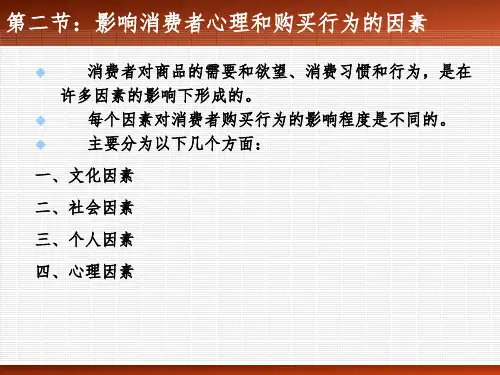
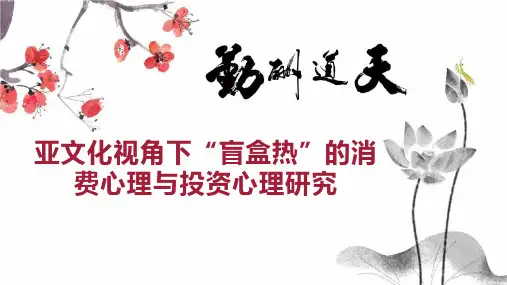
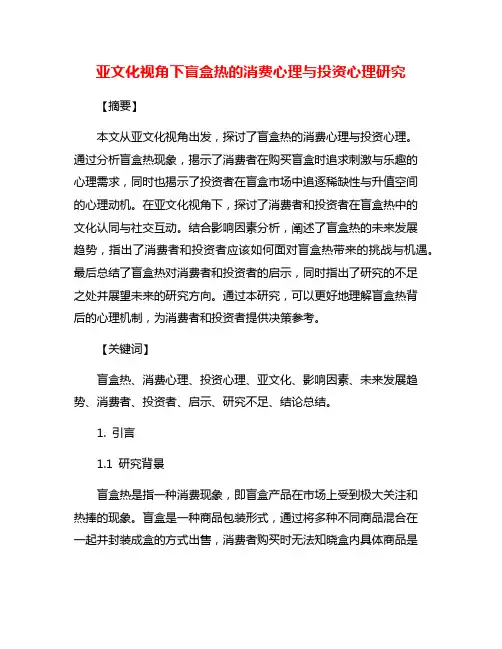
亚文化视角下盲盒热的消费心理与投资心理研究【摘要】本文从亚文化视角出发,探讨了盲盒热的消费心理与投资心理。
通过分析盲盒热现象,揭示了消费者在购买盲盒时追求刺激与乐趣的心理需求,同时也揭示了投资者在盲盒市场中追逐稀缺性与升值空间的心理动机。
在亚文化视角下,探讨了消费者和投资者在盲盒热中的文化认同与社交互动。
结合影响因素分析,阐述了盲盒热的未来发展趋势,指出了消费者和投资者应该如何面对盲盒热带来的挑战与机遇。
最后总结了盲盒热对消费者和投资者的启示,同时指出了研究的不足之处并展望未来的研究方向。
通过本研究,可以更好地理解盲盒热背后的心理机制,为消费者和投资者提供决策参考。
【关键词】盲盒热、消费心理、投资心理、亚文化、影响因素、未来发展趋势、消费者、投资者、启示、研究不足、结论总结。
1. 引言1.1 研究背景盲盒热是指一种消费现象,即盲盒产品在市场上受到极大关注和热捧的现象。
盲盒是一种商品包装形式,通过将多种不同商品混合在一起并封装成盒的方式出售,消费者购买时无法知晓盒内具体商品是什么,因此被称为盲盒。
近年来,盲盒热在中国市场迅速升温,吸引了大量消费者和投资者的目光。
盲盒热的背后反映了消费者对于未知和惊喜的追求,同时也体现了投资者对于潜在利润和投机机会的认知。
随着亚文化的兴起,盲盒产品逐渐成为一种亚文化的象征和符号,引发了人们对消费心理和投资心理的深入思考。
对盲盒热的消费心理与投资心理进行研究具有一定的重要性和现实意义。
通过深入分析盲盒热现象和探讨亚文化视角下的消费心理与投资心理,可以更好地理解盲盒热的形成原因和发展趋势,为消费者和投资者提供有益的参考和启示。
1.2 研究意义2. 盲盒热的兴起和蓬勃发展,反映了当下社会文化的多元化和年轻人消费观念的转变。
通过深入分析盲盒热现象,可以揭示消费者群体在选择购买盲盒时的心理动因和行为特征,为市场营销策略的制定提供参考。
3. 从投资角度来看,盲盒热不仅仅是一种消费行为,也被视为一种具有独特投资价值的商品。
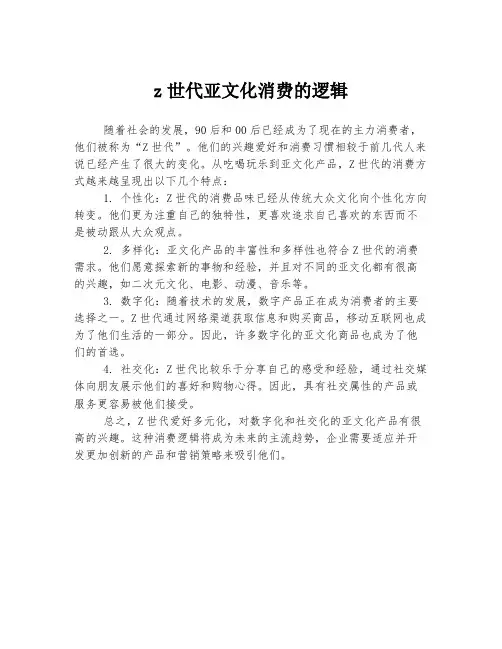
z世代亚文化消费的逻辑
随着社会的发展,90后和00后已经成为了现在的主力消费者,他们被称为“Z世代”。
他们的兴趣爱好和消费习惯相较于前几代人来说已经产生了很大的变化。
从吃喝玩乐到亚文化产品,Z世代的消费方式越来越呈现出以下几个特点:
1. 个性化:Z世代的消费品味已经从传统大众文化向个性化方向转变。
他们更为注重自己的独特性,更喜欢追求自己喜欢的东西而不是被动跟从大众观点。
2. 多样化:亚文化产品的丰富性和多样性也符合Z世代的消费需求。
他们愿意探索新的事物和经验,并且对不同的亚文化都有很高的兴趣,如二次元文化、电影、动漫、音乐等。
3. 数字化:随着技术的发展,数字产品正在成为消费者的主要选择之一。
Z世代通过网络渠道获取信息和购买商品,移动互联网也成为了他们生活的一部分。
因此,许多数字化的亚文化商品也成为了他们的首选。
4. 社交化:Z世代比较乐于分享自己的感受和经验,通过社交媒体向朋友展示他们的喜好和购物心得。
因此,具有社交属性的产品或服务更容易被他们接受。
总之,Z世代爱好多元化,对数字化和社交化的亚文化产品有很高的兴趣。
这种消费逻辑将成为未来的主流趋势,企业需要适应并开发更加创新的产品和营销策略来吸引他们。
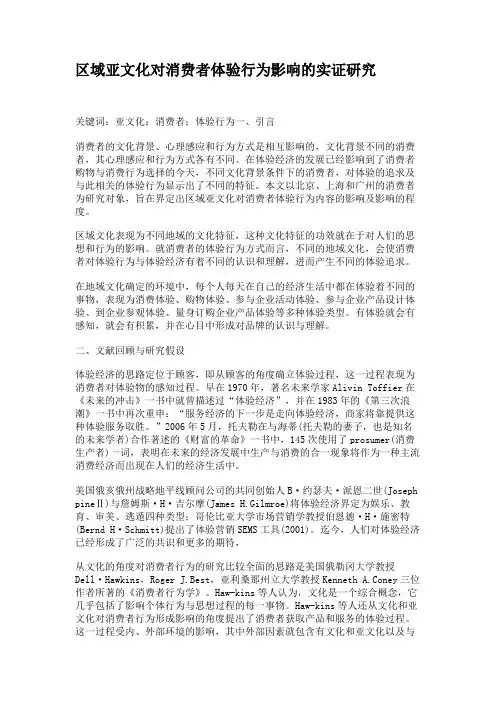
区域亚文化对消费者体验行为影响的实证研究关键词:亚文化;消费者;体验行为一、引言消费者的文化背景、心理感应和行为方式是相互影响的,文化背景不同的消费者,其心理感应和行为方式各有不同。
在体验经济的发展已经影响到了消费者购物与消费行为选择的今天,不同文化背景条件下的消费者,对体验的追求及与此相关的体验行为显示出了不同的特征。
本文以北京、上海和广州的消费者为研究对象,旨在界定出区域亚文化对消费者体验行为内容的影响及影响的程度。
区域文化表现为不同地域的文化特征,这种文化特征的功效就在于对人们的思想和行为的影响。
就消费者的体验行为方式而言,不同的地域文化,会使消费者对体验行为与体验经济有着不同的认识和理解,进而产生不同的体验追求。
在地域文化确定的环境中,每个人每天在自己的经济生活中都在体验着不同的事物,表现为消费体验、购物体验、参与企业活动体验、参与企业产品设计体验、到企业参观体验、量身订购企业产品体验等多种体验类型。
有体验就会有感知,就会有积累,并在心目中形成对品牌的认识与理解。
二、文献回顾与研究假设体验经济的思路定位于顾客,即从顾客的角度确立体验过程,这一过程表现为消费者对体验物的感知过程。
早在1970年,著名未来学家Alivin Toffier在《未来的冲击》一书中就曾描述过“体验经济”,并在1983年的《第三次浪潮》一书中再次重申:“服务经济的下一步是走向体验经济,商家将靠提供这种体验服务取胜。
”2006年5月,托夫勒在与海蒂(托夫勒的妻子,也是知名的未来学者)合作著述的《财富的革命》一书中,145次使用了prosumer(消费生产者)一词,表明在未来的经济发展中生产与消费的合一现象将作为一种主流消费经济而出现在人们的经济生活中。
美国俄亥俄州战略地平线顾问公司的共同创始人B·约瑟夫·派恩二世(Joseph pineⅡ)与詹姆斯·H·吉尔摩(James H.Gilmroe)将体验经济界定为娱乐、教育、审美、逃遁四种类型;哥伦比亚大学市场营销学教授伯恩德·H·施密特(Bernd H·Schmitt)提出了体验营销SEMS工具(2001)。
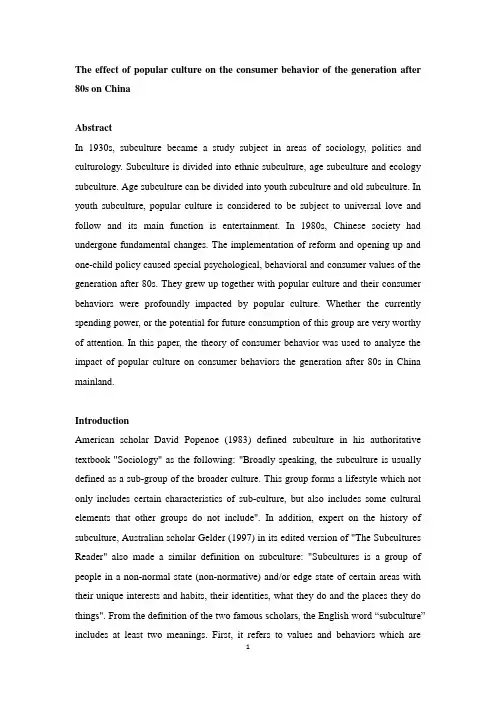
The effect of popular culture on the consumer behavior of the generation after 80s on ChinaAbstractIn 1930s, subculture became a study subject in areas of sociology, politics and culturology. Subculture is divided into ethnic subculture, age subculture and ecology subculture. Age subculture can be divided into youth subculture and old subculture. In youth subculture, popular culture is considered to be subject to universal love and follow and its main function is entertainment. In 1980s, Chinese society had undergone fundamental changes. The implementation of reform and opening up and one-child policy caused special psychological, behavioral and consumer values of the generation after 80s. They grew up together with popular culture and their consumer behaviors were profoundly impacted by popular culture. Whether the currently spending power, or the potential for future consumption of this group are very worthy of attention. In this paper, the theory of consumer behavior was used to analyze the impact of popular culture on consumer behaviors the generation after 80s in China mainland.IntroductionAmerican scholar David Popenoe (1983) defined subculture in his authoritative textbook "Sociology" as the following: "Broadly speaking, the subculture is usually defined as a sub-group of the broader culture. This group forms a lifestyle which not only includes certain characteristics of sub-culture, but also includes some cultural elements that other groups do not include". In addition, expert on the history of subculture, Australian scholar Gelder (1997) in its edited version of "The Subcultures Reader" also made a similar definition on subculture: "Subcultures is a group of people in a non-normal state (non-normative) and/or edge state of certain areas with their unique interests and habits, their identities, what they do and the places they do things". From the definition of the two famous scholars, the English word “subculture” includes at least two meanings. First, it refers to values and behaviors which areopposite to dominant culture, while it is included in the dominant culture but tries to distinguish it from dominant culture and is shared by a certain group. Second, it refers to a group of people or community sharing some subcultures. Both of the two meanings showed that subculture had characteristics of group self-identity and being excluded by mainstream society. That is that when a group formed a lifestyle with cultural identity different from dominant culture and cultural elements other groups do not, the group culture will be called subculture. From the above analysis, the sub-culture can refer to special behaviors of a group of people, and it can also mean a special lifestyle. From sociological point of view, subculture group is a group of people marked by mainstream society. They often are in the non-mainstream and subordinate position in society. They have many obvious features (such as deviation, marginal or even challenge) and special lifestyle different from other groups (especially dominant groups).In this paper, the youth subculture was defined as the unity of the concept and behavior of young people’s lives. It has some gaps from adult culture and adapts to the need of youth. The popular culture is the expression of youth subculture. Giddens (2000) had defined popular culture. It referred to the entertainment that were watched, read or participated in by hundreds of thousands of or millions of people. Popular culture is the artifacts which are commonly available to anyone, like films, tapes, CD or VCD, fashion, television programs, the mode of communication and exchange, etc." (Hebdige, 1993, p 361). When the meaning of modern consumption is beyond the basic survival but has the connotation of enjoyment, development, self-expression, etc. consumption in the eyes of young people has a special social significance. Many young people in modern society no longer see consumption just as survival needs, but as a show of self-innovation capability. So, the generation after 80s in China mainland becomes a special group of subculture.Consumer behavior of the generation after 80sFor the generation after 80s, they grew up together with popular culture. Open societyhas brought a lot of information, which make their vision broad and thinking quickly. In term of accessing to information, learning knowledge and even entertainment, they are deeply affected by the mass media. Campbell et al. (2011) investigated the channels for them to get the newest information. The results showed that movies, television, radio and newspapers were the top four. Some researchers used the "sensibility of pursuing aesthetic" to describe the generation after 80s, because they were more inclined to accept visually interesting information, such as attractive advertisements of various media, which increased the affinity and credibility of information, and were easily to make this generation produce identity to the goods (Guang-mei, 2010, p 16). Therefore, they have unique consumer behaviors.Individual consumptionYoung consumers seek different in rich shopping environment. Watches, handbags and various small accessories have become carriers for the young generation to express their unique styles. They generally agree that wearing must have their own personality, and they will consume and live in accordance with their own ideas. Customization is another consumption style for young consumers to pursue personalized. Young consumers no longer regard spending as an activity of mere trading or services, and no longer passively accept unilateral corporate marketing (Belleau et al., 2007, p 248). They demand as participants together with enterprise to research and develop their unique style of personalized products and services. They ask each product must be customized according to their preferences and needs and each service should be provided separately according to their requirements.Symbolic consumptionIn today's society, the replacement of popular culture such as 3G mobile phones, fashion, luxury goods, etc. is getting faster and faster. Affected by new things as well as their own sense of curiosity, the generation after 80s begins to pursue material enjoyment and famous brands. Because of being affected by the psychology of synchronous consumption, the generation after 80s advocates vogue and follows thefashion to show that they do not fall behind in the pursuit of fashion (Morgan and Birtwistle, 2009, p 192). They pursue petty bourgeoisie, even tattoos, bungee jumping and other extreme sports. Meanwhile, young consumers seek communication object during the consumption. They like to go to coffee shops like Starbucks to find like-minded people. At the same time to be recognized by others, they experience the pleasure of consumption.Consumption for developmentContemporary youths are willing to pay for their health for future development. They think that they have health but not necessarily have everything, while once they lost health they will lost everything. Traditional skin care and beauty gradually lost their appeal to youth. Instead sanitarian activities which help detoxify and regulate physical and mental health are popular, such as SPA, lymphatic drainage, the capsule and foot massage. Yoga, kickboxing and other fitness activities are also increasingly popular in young generation. In health club with annual fee of several thousand dollars, many youths can be seen. Subscription of various health magazines is performance of consumption of the generation after 80s for the development of their health.Hedonic consumptionThe generation after 80s stresses enjoying life. Enjoying life is a distinctive feature of the current youth consumption. It is two main performances. Firstly, experiencing consumption with the purpose of enjoyment and new experience is becoming a mainstream in youth consumption behavior. Tourism spending as an example, in the last year, the number of outbound Chinese people reached 98 million, with an increase of nearly forty percent over the previous year (China National Tourism Administration, 2014). Another way of enjoyment is to purchase new technological products and information. They purchase new products and obtain various types of information about their everyday lives and learning, such as news, entertainment, tourism transport, health, education services and so on. Reading e-newspapers is an example of a new consumption to enjoy life. Secondly, leisure consumption places increased.Cafe house, comic houses, bars, wholesale KTV, large playground, three-dimensional cinema, etc. become enjoyment places for the youth.Strong brand awareness and low brand loyaltyBecause of the psychology of symbolic consumption, young consumers gradually enter a new stage of symbolic consumption. The typical symbolic consumption is the brand consumption. Different from previous generations, the generation after 80s has strong brand awareness, but they have low brand loyalty.Easy and convenient consumptionThe younger generation creates relaxed consumption patterns to ease tensions in study and work. Style of clothing is towards to leisure. They no longer follow the traditional dress etiquette, but stress comfortable and relaxed feeling of the wearing. Even casual suit is towards to leisure. In addition, adult toys and cartoons are prevalent. In the fast-paced life and work, the youth is in the state of fierce competition, so they go to relax by adult toys and cartoons. A survey showed that more than half of young people said that they would consider buying for their own toys, where about one-third of young people thought they liked and were willing to buy toys. They also like to buy cartoons and comics to make people feel good, so as to achieve the purpose of relaxation (Tsun, 2012). Moreover, young generation looks for quick and easy consumption patterns to simplify their lives. They change their shopping mode. They like staying at home to consume, such as mailing letters using courier companies, ordering merchandise through telephone, shopping online, etc. Contrary to traditional thrift, young consumers would rather pay more to reduce the waste of time and effort. They are willing to 24 hours shopping. In order to be able to shop at any time, young people would rather pay a higher price to a 24-hour convenience store. They also change the way of meal. Young people are accustomed to eating at restaurants. Ordering meal by telephone is instead of the traditional home cooking.Significantly conspicuous consumptionThe generation after 80s grew under the social context of emphasizing on capacity, money and status. Materialistic characteristics of this generation are more obvious than their parents. They pay more attention to self-realization and have more intense desire to succeed. Successful people instead of the hero become life model. They never deny yearning for wealth and tend to evaluate personal values and social status based on the wealth of the people. They also like to show off. Communist Youth League Central Propaganda Department, in June-July 2002, conducted a survey about the best fancy factor for buying something among the generation after 80s and their parents. In the options of brand, quality, style, price and several other options, the youth were more fancy “style” (49.1%), parents w ere more fancy "quality" (57.9%). Intense pursuit of style indicates conspicuous consumption characteristics of this generation. Conspicuous consumption is not compared with the wealth of the rich, but with their own taste and the ability to pursue fashion (Podoshen et al., 2011, p 19). 4.2% of respondents said their clothing was mainly showed to others to avoid being looked down upon. 19% respondents said their clothing was mainly for them to feel happy.20.7% respondents said their clothing was both for others to see and to feel happy for themselves. 36.8 % respondents thought that famous brand was representative of good quality and durableness, and also had a face. A total of 80.7% of young people regarded showing off as a factor for consumption.Popular culture’s effect on consumer behaviorGrowing young people is the largest society group for consumption. When the meaning of modern consumption is beyond the basic survival and has the connotation of enjoyment, development, self-expression, etc., consumption in the eyes of young people has a special social significance. Many young people in modern society no longer just consider consumption as the survival needs, but as a big stage to show their innovation capability, so that young people's consumption behaviors have features of restless pursuit of the avant-garde and innovative (Wang, 2012). Being pioneer and advocator of fashion and leading the trend of the social consumption with its own unique consumption culture and taste become the most prominent features ofconsumption behaviors of modern youth consumers. With the socio-economic and cultural development, and the improvement of income levels, the quality of innovation and consumption ability, the characteristics of initiative and leading main activities of the youth in popular culture will become increasingly prominent. Their dominant position will become increasingly visible and important. In the past two decades, several consumption popular cultures with great impact in the world were closely related to the main characteristics of consumer behaviors of the youth. For example, yuppie fashion of attention to brands and advocating luxury consumer goods rose in Europe and America in 1980s. The frugal environmentally friendly fashion of advocating less energy consumption, reducing pollution and natural regression appeared in 1990s. Both the advocators and practitioners were the youth.In addition to innovation of avant-garde young people, popular culture of consumption in modern society is largely stimulated by new products to market and consumption advertising of the manufacturers, such as three-dimensional advertising when manufacturers put new products into market, the showing of popular consumption styles and consumption goods from developed countries through the mass media. But these new consumption goods and styles on advertising are not identified, accepted and practiced by the youth at the beginning. Youth’s idea is emancipated. They are curious and most easy to find and accept new things, new ideas and new behaviors, and thus are always the testers of new products and new models and active promoters of new consumption patterns. Early 1980s, when Souba pants, jeans and tights went into China, they were braved all kinds of criticism and disapproval. The youth wore them with the contempt attitudes for convention. It was their demonstration effect that these clothing called "bourgeois fancy dress" was extended to the rest of society at different levels of ages, and ultimately got the community's identity and following. Now, it is still the cowboy fashion. Premium sound, DVD players, mobile phones, computers and internet appeared in 1990s were also the first to be accepted and enjoyed by the youth, thus forming the spectacular high-tech appliances fashion. It there were no keen perception, acceptance andpositive demonstration of new consumption products and styles of the youth, the new consumption products and styles would be difficult to go public and form consumption popular cultures to change consumers’ a ttitudes and behaviors one after another. Youth groups’ behavior characteristics of positive demonstration of new consumption products and styles bring convenience for manufacturers to promote their new business and services. Manufacturers’ advertisements are always targeting to youth. They use emotional expression and language which youth prefers and use teen idols as advertising model to attract the attention of young people to their new products (Bingqing, 2011, p 192). They make young people get recognition and acceptance, and then their products can be spread to all sectors of society under the first demonstration in youth, thus forming influential popular culture consumption. The leading consumption behaviors of youth when they face new products and new advertising have become indispensable stimulus strength to increase and expand costumers' demands in modern society.Youth’s conformity consumption behaviors become the main characteristic of popular culture consumption. For the whole youth groups, the youth who play the role of pioneers in consumer popular culture are the minority, and the number of youth as fuglemen and demonstrators is also limited (Yu, 2010, p 7). As pioneers and demonstrators of popular culture, they need a strong quality of autonomy, independence and innovative. In addition, they also need for more adequate leisure time with strong spending power. For the youth with relatively poor autonomy, busy academic and work and limited spending power, their main consumption behaviors are to chase popular culture. This part of youth yearns for each consumption popular culture. They are envious of the advocators who express their own unique fashion by their clothing, food, shelter, and other daily consumptions. They are also envious of life styles and dress of various famous stars that frequently appear on mass media. They think that only like them, they can show their youthful vigor. Thus they are always scrambling to emulate their idols’ consumption patterns. They believe that what is popular is good and beautiful and they can choose and follow it withoutthinking. Since 1980s, the appearance of consumption popular culture such as star craze, dancing craze, fashion craze, luxury wedding craze, wedding color photo craze, home improvement craze, high-tech appliances craze, and so on created huge consumer forces after the formation of consumption popular culture through many youth’s comparisons and chases. Youth’s consumer behavior characteristics of following, conformity and comparisons of consumption popular culture on the one hand play a role of stimulating and pulling the social consumption demands, increasing consumption of the whole society and promoting economic development (Ren, 2012, p 354). On the other hand, some of the youth are naïve with poor independent, strong herd, blind credulity and like comparisons, so they are easy to be injured by bad consumption culture. In this regard, youth consumer behavior has the obvious features of passivity in popular culture consumption. Therefore, it specially needs community to strengthen their education of consumption attitudes and guide their consumer behaviors to enhance the ability of identify and resilience to adverse consumption of popular culture.ConclusionSince the subculture directly affects social psychosocial environment for people to live, its influence is often greater than the dominant culture. It can give people particular spirit and temperament belonging to a group or collective to identify the identities. Generally speaking, youth subcultures reflect the adult cultures, but in particular, the youth subculture is unique. Although the proportion of the generation after 80s in the total national population is small (less than 15%), as an important force in the future of Chinese society, they are increasingly becoming the focus of the entire community. They have optimistic expectations of future income and there is a huge contrast between their consumer values and traditional forms of consumption. Their huge consumption potential heralds the arrival of a new wave of consumption and rapidly becoming the new main consumers of China. This generation grew up with Chinese popular culture and their consumption psychology was impacted by the popular culture. The correlation between the characteristics of youth consumerbehavior and modern popular culture of consumption is the result of conjunction of contemporary youth’s unique social and psychological characteristics and the intrinsic nature of popular culture of consumption. This natural conjunction strengthens the interaction between popular culture of consumption and young people. On one hand, popular culture of consumption must meet youth’s needs of consumption, tastes and values to make youth culture traits affect or even lead the changing content and trend of popular culture of consumption to some extent. On the other hand, the popular culture of consumption can produce multiple effects on youth’s needs of consumption, tastes and values from the specific level of consumption. So the study of the impact of popular culture on the consumer behavior of the generation after 80s has great significance to corporate marketing strategy..ReferenceBelleau, B. D., Summers, T. A., Xu, Y. & Pinel, R. (2007). Theory of reasoned action purchase intention of young consumers. Clothing and Textiles Research Journal. 25, 244-257.Bingqing, Y. (2011). Advertising marketing communication strategy under the background of media convergence-based on the generation after 80s advertising of audience behavior changes. Advances in Computer Science, Intelligent System and Environment. 104, 191-196.Campbell, R., Martin, C. R. & Fabos, B. (2011). Media and culture: An introduction to mass communication. Macmillan.Gelder, K., & Thornton, S. (1997). The subcultures reader. Routledge.Giddens, A. (2001). The second globalization debate. A talk with Antony Giddens. EDGE: The Third Culture. Edge www. edge. org/3rd_culture/giddens/giddens_p4. html[Links].Guang-Mei, D. (2010). On Popularity of" the Generation after 80s" Literature from Readers Aesthetic Expectations Horizon. Journal of Beijing Institute of Graphic Communication, 3, 016.Hebdige, D. (1993). From culture to hegemony. The cultural studies reader, 357-367. Morgan, L. R. & Birtwistle, G. (2009). An investigation of young fashion consumers' disposal habits. International Journal of Consumer Studies. 33, 190-198. Podoshen, J. S., Li, L. & Zhang, J. (2011). Materialism and conspicuous consumption in China: A cross‐cultural examination. International Journal of Consumer Studies. 35, 17-25.Popenoe, D. (1983). Sociology: Study Guide and Workbook, Prentice-Hall.Ren, Y. J. (2012). Characteristics and trends about China’s trade on internet. Engineering Education and Management. 111, 353-357.Tsun, Y. 2012. My direct reports: Office toys for young adults. Available at /1850/15416Wang, Y. (2012). Spouse selection amongst China’s post-1980 generation. (Doctoral dissertation, Central European University).Yu, Y. (2010). A comparative research on consumer behavior of" after 80s" and" after 90s. Advertising Panorama. 4, 007.。
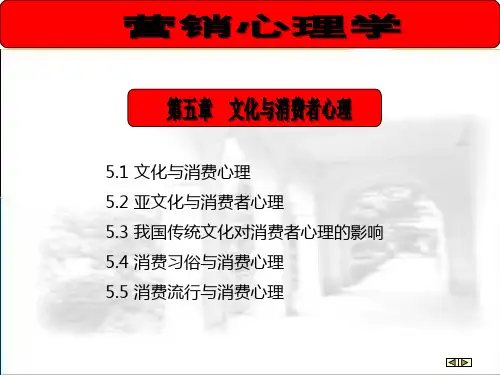
区域亚文化对消费者体验行为影响的实证研究关键词:亚文化;消费者;体验行为一、引言消费者的文化背景、心理感应和行为方式是相互影响的,文化背景不同的消费者,其心理感应和行为方式各有不同。
在体验经济的发展已经影响到了消费者购物与消费行为选择的今天,不同文化背景条件下的消费者,对体验的追求及与此相关的体验行为显示出了不同的特征。
本文以北京、上海和广州的消费者为研究对象,旨在界定出区域亚文化对消费者体验行为内容的影响及影响的程度。
区域文化表现为不同地域的文化特征,这种文化特征的功效就在于对人们的思想和行为的影响。
就消费者的体验行为方式而言,不同的地域文化,会使消费者对体验行为与体验经济有着不同的认识和理解,进而产生不同的体验追求。
在地域文化确定的环境中,每个人每天在自己的经济生活中都在体验着不同的事物,表现为消费体验、购物体验、参与企业活动体验、参与企业产品设计体验、到企业参观体验、量身订购企业产品体验等多种体验类型。
有体验就会有感知,就会有积累,并在心目中形成对品牌的认识与理解。
二、文献回顾与研究假设体验经济的思路定位于顾客,即从顾客的角度确立体验过程,这一过程表现为消费者对体验物的感知过程。
早在1970年,著名未来学家Alivin Toffier在《未来的冲击》一书中就曾描述过“体验经济”,并在1983年的《第三次浪潮》一书中再次重申:“服务经济的下一步是走向体验经济,商家将靠提供这种体验服务取胜。
”2006年5月,托夫勒在与海蒂(托夫勒的妻子,也是知名的未来学者)合作著述的《财富的革命》一书中,145次使用了prosumer(消费生产者)一词,表明在未来的经济发展中生产与消费的合一现象将作为一种主流消费经济而出现在人们的经济生活中。
美国俄亥俄州战略地平线顾问公司的共同创始人B·约瑟夫·派恩二世(Joseph pineⅡ)与詹姆斯·H·吉尔摩(James H.Gilmroe)将体验经济界定为娱乐、教育、审美、逃遁四种类型;哥伦比亚大学市场营销学教授伯恩德·H·施密特(Bernd H·Schmitt)提出了体验营销SEMS工具(2001)。